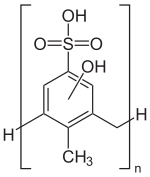Policresulen
| Structural formula | |||||||||
|---|---|---|---|---|---|---|---|---|---|

|
|||||||||
| General | |||||||||
| Surname | Policresulen | ||||||||
| other names | |||||||||
| CAS number | 101418-00-2 | ||||||||
| Monomer | m-cresol sulfonic acid | ||||||||
| Molecular formula of the repeating unit | C 8 H 8 O 4 S | ||||||||
| Molar mass of the repeating unit | 200.21 g mol −1 | ||||||||
| PubChem | 3050404 | ||||||||
| ATC code | |||||||||
| Drug information | |||||||||
| Drug class | |||||||||
| properties | |||||||||
| safety instructions | |||||||||
|
|||||||||
| As far as possible and customary, SI units are used. Unless otherwise noted, the data given apply to standard conditions . | |||||||||
Policresulen is an antiseptic -acting drug . It is a polycondensation product , which consists of methylene-bridged m - cresol - sulfonic acids of different chain lengths.
Mode of action
The effectiveness of Policresulen is based on three partially synergetic mechanisms of action:
- Antimicrobial effect on bacteria, fungi and protozoa due to the high acidity (acid character) and denaturation.
- Denaturation in dead and pathologically changed tissue.
Denaturation is achieved through specific coagulation of pathologically changed or necrotic tissues. The coagulation and elimination of dead tissue stimulate wound healing processes and promote re-epithelialization. Healthy tissue is hardly attacked. In detail, contact with necrotic tissue leads to swelling of the plasma and nucleus and subsequent shrinkage of the cell.
- Hemostypical effectiveness through coagulation of blood protein and severe vascular constriction.
Pharmacokinetics
Policresulen is only applied locally. Pharmacokinetic data have not been established. Therefore nothing is known about the resorption of Policresulen.
application areas
Due to its diverse effects, there are similarly diverse application possibilities.
Dentistry
- Local treatment of ulcer inflammations of the oral mucosa and the gums (e.g. vesicles, aphthous ulcers , ...)
Ear, nose and throat medicine
- Hemostasis after operations (e.g. tonsil surgery) and nosebleeds .
Surgery and dermatology
- For accelerated rejection of dead tissue after burns, cleaning and stimulation of healing (e.g. after small burns, venous leg ulcers, decubitus, with chronic inflammatory processes and genital warts, etc.)
- Hemostasis in the case of oozing bleeding and treatment of inflammatory, bleeding processes (e.g. hemorrhoids ); also in combination with the local anesthetic cinchocaine .
Gynecology
- Local treatment of cervical infections and inflammation of the vagina or infections and tissue defects as well as genital warts and the like. Ä.
- Local treatment of portioectopy
- Hemostasis after biopsy and removal of uterine polyps.
- Chlamydial infection of the lower genitourinary tract
- Candidiasis (fungal infection) of the vulva and vagina
- trichomoniasis urogenital
Veterinary medicine
- Disinfectant and astringent for horses, cattle, sheep, goats and dogs.
Dosage forms
Policresulen are available in liquid form (solution), as vaginal suppositories and as gel for veterinary medicine.
Trade names
- Monopreparations
- Albothyl (D), Negatol (CH), Lotagen ad us. vet. (D)
- Combination preparations
- with cinchocaine: Faktu (CH)
Web links
- Open Drug Database: Policresulen
Individual evidence
- ↑ This substance has either not yet been classified with regard to its hazardousness or a reliable and citable source has not yet been found.